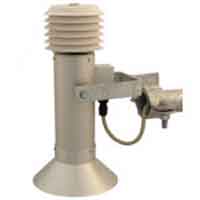Description
Recording snow depth is an important parameter for characterizing the snow cover in the field. Its formation is subject to strong spatial and temporal fluctuations. Influencing factors include the influence of other weather events (air temperature, wind, radiation, etc.), terrain characteristics, and spatial precipitation in the area.
Based on the reflected signals and the required travel time of the ultrasonic signals, the USH-8 sensor calculates the current snow depth. The air temperature has a significant influence on the travel time of the ultrasonic pulse. Therefore, the snow depth sensor features integrated temperature compensation. This incorporates the influence of air temperature on the travel time of the ultrasonic signals into the snow depth calculation. The calculation takes place within the sensor, so the output signal provides the already processed snow depth. This achieves optimal measurement results with an accuracy of 0.1% (FS).
The USH-8 sensor automatically switches between measurement and standby mode during operation. The data logger is not allowed to switch the sensor on and off, thus achieving extremely energy-efficient operation. For measured value transfer, the USH-8 sensor is activated by the data logger using a "transfer pin." For a full day's measurement, with minute-by-minute measurements, only 0.5 Ah is required. Between measurement phases, the sensor automatically switches to standby mode.
The measuring site should be as flat, sheltered from wind, and avalanche-safe as possible. Steep slopes, hollows, edges, or large rocks in the immediate vicinity of the measuring site should be avoided. A steep slope of the snowfield poses the risk of the snowpack sliding, thus distorting the measurement result. To ensure accurate measurements, the sensor must be aligned parallel to the ground. Slight inclinations of the ground can be compensated for by correctly aligning the sensor using the included mount. Furthermore, the expected snow depth at the measuring site should be estimated in advance to ensure the appropriate sensor mounting height.
The correct selection and placement of the measuring point is of great importance.
The sensor is delivered pre-calibrated (temperature compensation) and pre-configured. In addition to the customer-specific settings (interface, protocol, etc.), only the zero point needs to be parameterized on site after installation. This is done easily and conveniently using Windows Hyperterminal. The optimal mounting height for the sensor is 3 m or more. A maximum permissible mounting height of 10 m is required. It must be noted that the diameter of the measuring field in this case is more than 3 m. To avoid disturbing the measuring field, two distances must be observed when setting up the station. Firstly, the distance between the sensor and the measuring field, and secondly, the distance between the sensor and the mast/mast foundation. Disturbances in the measuring field can lead to unwanted reflections and thus to distorted measured values. Objects close to the measuring field (e.g., edges of the terrain, buildings, etc.) also generate snow drifts and thus unwanted disturbances in the measuring field.
The material of the measuring field surface should be representative
Easy integration into existing weather stations with an analogue (0/4-20 mA signal) and a digital interface (RS 232). The included mast mount also allows for easy installation.
The measured value of the USH-8 snow depth sensor can be optionally measured using a
- Ultrasonic sensor for snow depth measurement with integrated temperature compensation
- Ultrasonic frequency 50 kHz and beam angle 12°
- Resolution 1mm
- Accuracy 0.1% (FS)
- Measuring range 0 to 10m
- · Analog 4..20 mA interface
- · Serial interface with ASCII transmission protocol and output of snow depth and temperature
- · Operating range from -35°C to +60°C
- Parameterization via Hyperterminal

